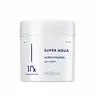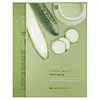What's inside
What's inside
 Key Ingredients
Key Ingredients

 Benefits
Benefits

 Concerns
Concerns

 Ingredients Side-by-side
Ingredients Side-by-side

Water
Skin ConditioningGlycerin
HumectantDiglycerin
HumectantNiacinamide
SmoothingTrehalose
Humectant1,2-Hexanediol
Skin ConditioningCaprylic/Capric Triglyceride
MaskingVinyldimethicone
Pentylene Glycol
Skin ConditioningCaprylyl Methicone
Skin ConditioningIsoamyl Laurate
EmollientAcrylates/C10-30 Alkyl Acrylate Crosspolymer
Emulsion StabilisingAmmonium Acryloyldimethyltaurate/Vp Copolymer
Hydroxyacetophenone
AntioxidantTromethamine
BufferingGlyceryl Acrylate/Acrylic Acid Copolymer
HumectantDimethiconol
EmollientCitrus Aurantium Bergamia Fruit Oil
MaskingXanthan Gum
EmulsifyingAdenosine
Skin ConditioningCitric Acid
BufferingCetearyl Olivate
Lavandula Angustifolia Oil
MaskingSorbitan Olivate
EmulsifyingCitrus Aurantium Dulcis Peel Oil
MaskingSodium Phytate
Dipotassium Glycyrrhizate
HumectantPinus Sylvestris Leaf Oil
MaskingPropanediol
SolventSodium Hyaluronate
HumectantBenzyl Glycol
SolventHydrolyzed Glycosaminoglycans
HumectantHydroxypropyltrimonium Hyaluronate
Sodium Hyaluronate Crosspolymer
HumectantGlyceryl Glucoside
HumectantHydrolyzed Hyaluronic Acid
HumectantButylene Glycol
HumectantEthylhexylglycerin
Skin ConditioningXylitylglucoside
HumectantMethyl Diisopropyl Propionamide
MaskingAnhydroxylitol
HumectantSodium Acetylated Hyaluronate
HumectantDipropylene Glycol
HumectantXylitol
HumectantSucrose Palmitate
EmollientHydrogenated Lecithin
EmulsifyingHyaluronic Acid
HumectantHydrolyzed Sodium Hyaluronate
Skin ConditioningMacadamia Ternifolia Seed Oil
EmollientOlea Europaea Fruit Oil
MaskingSimmondsia Chinensis Seed Oil
EmollientVitis Vinifera Seed Oil
EmollientActinidia Polygama Fruit Extract
Skin ConditioningCholeth-24
EmulsifyingGlyceryl Caprylate
EmollientPotassium Hyaluronate
Skin ConditioningMagnesium Chloride
Tetradecyl Aminobutyroylvalylaminobutyric Urea Trifluoroacetate
Skin ConditioningCeramide NP
Skin ConditioningWater, Glycerin, Diglycerin, Niacinamide, Trehalose, 1,2-Hexanediol, Caprylic/Capric Triglyceride, Vinyldimethicone, Pentylene Glycol, Caprylyl Methicone, Isoamyl Laurate, Acrylates/C10-30 Alkyl Acrylate Crosspolymer, Ammonium Acryloyldimethyltaurate/Vp Copolymer, Hydroxyacetophenone, Tromethamine, Glyceryl Acrylate/Acrylic Acid Copolymer, Dimethiconol, Citrus Aurantium Bergamia Fruit Oil, Xanthan Gum, Adenosine, Citric Acid, Cetearyl Olivate, Lavandula Angustifolia Oil, Sorbitan Olivate, Citrus Aurantium Dulcis Peel Oil, Sodium Phytate, Dipotassium Glycyrrhizate, Pinus Sylvestris Leaf Oil, Propanediol, Sodium Hyaluronate, Benzyl Glycol, Hydrolyzed Glycosaminoglycans, Hydroxypropyltrimonium Hyaluronate, Sodium Hyaluronate Crosspolymer, Glyceryl Glucoside, Hydrolyzed Hyaluronic Acid, Butylene Glycol, Ethylhexylglycerin, Xylitylglucoside, Methyl Diisopropyl Propionamide, Anhydroxylitol, Sodium Acetylated Hyaluronate, Dipropylene Glycol, Xylitol, Sucrose Palmitate, Hydrogenated Lecithin, Hyaluronic Acid, Hydrolyzed Sodium Hyaluronate, Macadamia Ternifolia Seed Oil, Olea Europaea Fruit Oil, Simmondsia Chinensis Seed Oil, Vitis Vinifera Seed Oil, Actinidia Polygama Fruit Extract, Choleth-24, Glyceryl Caprylate, Potassium Hyaluronate, Magnesium Chloride, Tetradecyl Aminobutyroylvalylaminobutyric Urea Trifluoroacetate, Ceramide NP
Water
Skin ConditioningGlycerin
HumectantButylene Glycol
HumectantPropylene Glycol
HumectantCucumis Sativus Fruit Extract
EmollientAloe Barbadensis Leaf Extract
EmollientPortulaca Oleracea Extract
Skin ConditioningSodium Hyaluronate
HumectantAllantoin
Skin ConditioningBetaine
HumectantHamamelis Virginiana Water
AstringentArginine
MaskingCarbomer
Emulsion StabilisingPhenoxyethanol
PreservativePolysorbate 80
EmulsifyingDipotassium Glycyrrhizate
HumectantEthylhexylglycerin
Skin ConditioningTocopheryl Acetate
AntioxidantDisodium EDTA
Sodium PCA
HumectantHydroxyethylcellulose
Emulsion StabilisingParfum
MaskingWater, Glycerin, Butylene Glycol, Propylene Glycol, Cucumis Sativus Fruit Extract, Aloe Barbadensis Leaf Extract, Portulaca Oleracea Extract, Sodium Hyaluronate, Allantoin, Betaine, Hamamelis Virginiana Water, Arginine, Carbomer, Phenoxyethanol, Polysorbate 80, Dipotassium Glycyrrhizate, Ethylhexylglycerin, Tocopheryl Acetate, Disodium EDTA, Sodium PCA, Hydroxyethylcellulose, Parfum
Ingredients Explained
These ingredients are found in both products.
Ingredients higher up in an ingredient list are typically present in a larger amount.
Butylene Glycol (or BG) is used within cosmetic products for a few different reasons:
Overall, Butylene Glycol is a safe and well-rounded ingredient that works well with other ingredients.
Though this ingredient works well with most skin types, some people with sensitive skin may experience a reaction such as allergic rashes, closed comedones, or itchiness.
Learn more about Butylene GlycolDipotassium Glycyrrhizate comes from licorice root.
Extracts of licorice have demonstrated to have antibacterial, anti‐inflammatory, antiviral, antioxidant properties.
One component, glabridin, has extra potent antioxidant and soothing properties. It has also been found to block pigmentation from UVB rays in guinea pigs.
Licorice Root also contains a flavonoid. Flavonoids are a natural substance from in plants. Flavonoids also have antioxidant properties.
Another component, glycyrrhizin, has been found to have anti-inflammatory and antimicrobial benefits. This may make licorice root extract effective at treating acne. However, more research is needed to support this.
Liquiritin is one of the flavone compounds found in licorice. It has been found to help lighten skin by preventing tyrosinase from reacting with tyrosine. When the two react, protein is converted to melanin. Melanin is the substance in your body that gives your features pigmentation.
Licorice root is native to Southern Europe and Asia. It has been used in traditional Chinese medicine to help with respiratory issues.
Learn more about Dipotassium GlycyrrhizateEthylhexylglycerin (we can't pronounce this either) is commonly used as a preservative and skin softener. It is derived from glyceryl.
You might see Ethylhexylglycerin often paired with other preservatives such as phenoxyethanol. Ethylhexylglycerin has been found to increase the effectiveness of these other preservatives.
Glycerin is already naturally found in your skin. It helps moisturize and protect your skin.
A study from 2016 found glycerin to be more effective as a humectant than AHAs and hyaluronic acid.
As a humectant, it helps the skin stay hydrated by pulling moisture to your skin. The low molecular weight of glycerin allows it to pull moisture into the deeper layers of your skin.
Hydrated skin improves your skin barrier; Your skin barrier helps protect against irritants and bacteria.
Glycerin has also been found to have antimicrobial and antiviral properties. Due to these properties, glycerin is often used in wound and burn treatments.
In cosmetics, glycerin is usually derived from plants such as soybean or palm. However, it can also be sourced from animals, such as tallow or animal fat.
This ingredient is organic, colorless, odorless, and non-toxic.
Glycerin is the name for this ingredient in American English. British English uses Glycerol/Glycerine.
Learn more about GlycerinSodium Hyaluronate is hyaluronic acid's salt form. It is commonly derived from the sodium salt of hyaluronic acid.
Like hyaluronic acid, it is great at holding water and acts as a humectant. This makes it a great skin hydrating ingredient.
Sodium Hyaluronate is naturally occurring in our bodies and is mostly found in eye fluid and joints.
These are some other common types of Hyaluronic Acid:
Learn more about Sodium HyaluronateWater. It's the most common cosmetic ingredient of all. You'll usually see it at the top of ingredient lists, meaning that it makes up the largest part of the product.
So why is it so popular? Water most often acts as a solvent - this means that it helps dissolve other ingredients into the formulation.
You'll also recognize water as that liquid we all need to stay alive. If you see this, drink a glass of water. Stay hydrated!
Learn more about Water